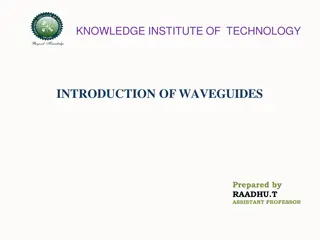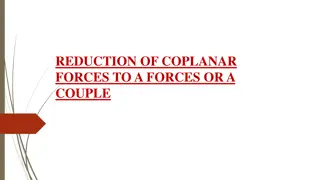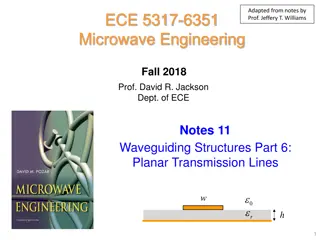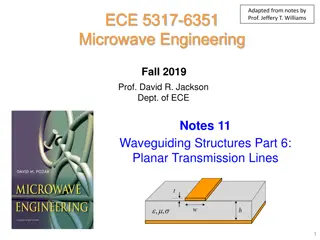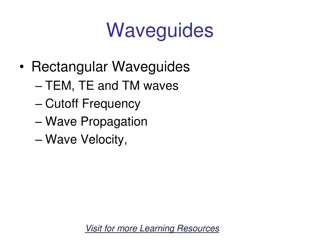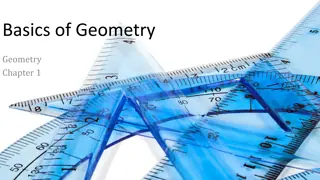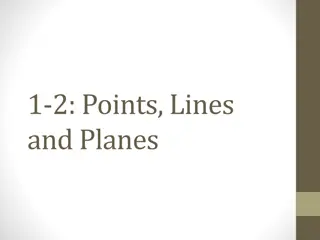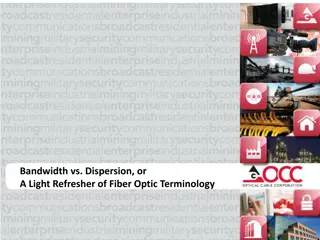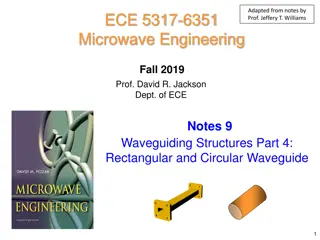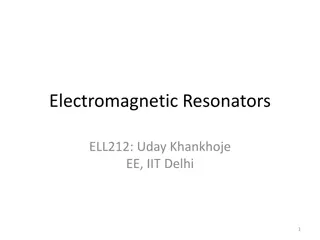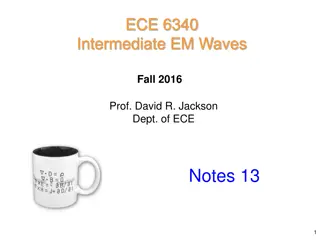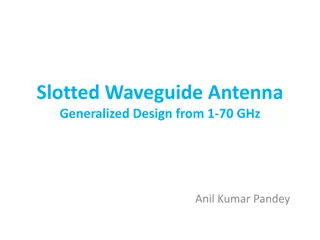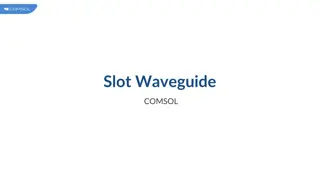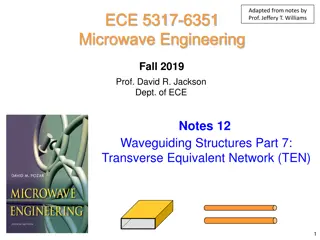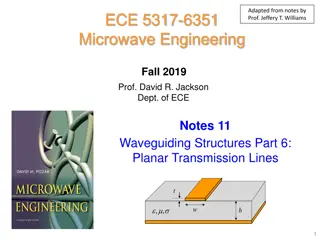Introduction to Waveguides and Their Advantages
Waveguides are structures that transmit electromagnetic waves, offering advantages over traditional transmission lines such as higher power handling capacity, lower loss, and the ability to operate at higher frequencies. They come in different shapes like rectangular and circular, with distinct mode
2 views • 15 slides
Coplanar Forces and their Classification
Coplanar forces are forces that lie in the same plane and can be classified into concurrent, parallel, non-concurrent, and non-parallel systems. These forces can be reduced to a single force or a couple for analysis. Understanding these force systems is essential in engineering and physics to determ
3 views • 20 slides
Overview of Planar Transmission Lines in Microwave Engineering
This document details various types of planar transmission lines such as microstrip, stripline, coplanar waveguide, and slotline used in microwave engineering. It covers the characteristics, field structures for TEM mode, analysis methods, conformal mapping solutions, and considerations for effectiv
3 views • 25 slides
Planar Transmission Lines: A Comprehensive Overview
Exploring various planar transmission lines like Microstrip, Stripline, Coplanar Waveguide, and Slotline. Understanding the field structures, analysis complexities, and solutions using conformal mapping in Stripline designs. Detailed discussions on characteristic impedance and effective width calcul
0 views • 24 slides
Forces in Mechanics: Fundamentals and Applications
Prof. Madhuri Reddy, an Assistant Professor at Hope Foundation's International Institute of Information Technology, explains the characteristics of forces, systems of forces, and the concept of resultant force and composition of forces in mechanics. Forces are defined as agents that produce or destr
0 views • 11 slides
Points, Lines, and Planes in Geometry
Explore the fundamental concepts of points, lines, and planes in geometry. Learn how to name them, identify collinear points and coplanar elements, understand segments and rays, and delve into the intersections of planes through postulates. Enhance your geometric knowledge with clear definitions, di
0 views • 19 slides
Geometry Basics: Points, Lines, and Planes
Learn about the fundamental concepts in geometry such as points, lines, and planes, along with their characteristics and relationships. Explore undefined and defined terms, collinear and coplanar points, line segments, rays, and opposite rays.
4 views • 13 slides
Rectangular Waveguides and Cutoff Frequency
Investigate waveguides supporting non-TEM modes like TE and TM, where cutoff frequency is crucial. Rectangular waveguides with TE and TM modes are explored, detailing mode orders and field configurations. The cutoff frequency formula and standard waveguide designations are also discussed, along with
0 views • 7 slides
Basics of Geometry: Understanding Points, Lines, and Planes
Explore the fundamental concepts of geometry in this slideshow developed to accompany the textbook "Big Ideas Geometry." Learn about points, lines, and planes, their characteristics, how they are named, and their relationships in space. Gain a clear understanding of line segments, rays, collinear po
1 views • 55 slides
Bounded Degree Polyhedronization of Point Sets in R3
The problem of finding a polyhedron in R3 with no four points coplanar, having the set of points as vertices, being simple in structure, with each vertex connected to O(1) edges, and featuring both a tetrahedralization and chain dual. This task has historical importance with Euler's formula setting
0 views • 24 slides
Introduction to Points, Lines, and Planes in Geometry
Exploring the fundamental concepts of points, lines, and planes in geometry, including definitions, examples, and postulates. Learn about collinear points, coplanar points, segments, rays, and key postulates in geometry.
1 views • 18 slides
Inhibited Spontaneous Emission in Physics
The study delves into inhibited spontaneous emission in physics, focusing on the phenomena, experimental setups, and effects like the Purcell effect. It discusses using waveguides and Rydberg atoms for this purpose, as well as the density of modes and states in free space and cavity configurations.
0 views • 16 slides
Bandwidth and Dispersion in Fiber Optic Communication
This presentation provides a comprehensive overview of bandwidth and dispersion in fiber optic communication. It covers essential terminologies like microns, nanometers, millimeters, and dB, explaining concepts such as bandwidth capacity, dispersion cancellation, and modal bandwidth in multimode fib
0 views • 24 slides
Resonance Phenomena in Grating Structures and Applications
Resonance phenomena in grating structures, such as dielectric or metal gratings on substrates, offer sensitive elements for detecting biological and chemical agents. The sensitivity of these structures is described by equations relating to resonant wavelength changes and the refractive index of inve
1 views • 20 slides
Agree/Disagree
Uncover fundamental concepts in geometry through images and definitions, including points, lines, planes, and geometric postulates. Gain insights into parallel lines, coplanar points, rays, circles, and more essential geometry principles.
0 views • 16 slides
Intermediate EM Waves: Vector Wave Equations and Waveguide Fields
The vector wave equations and waveguide fields in intermediate electromagnetic waves, as discussed in Prof. David R. Jackson's fall 2016 ECE 6340 course notes. Learn about the wave equation, Laplacian, Helmholtz equation, and wave impedance in the context of electromagnetic wave propagation.
0 views • 17 slides
Geometry Concepts: Lines, Intersections, and Types
In this activity, students work independently on identifying characteristics of different types of lines, intersections, and spatial relationships in geometry. The content includes fill-in-the-blank exercises, questions about coplanar lines, and examples of oblique, perpendicular, parallel, and skew
0 views • 17 slides
Calculate Resultant Force and Angle for Coplanar Concurrent Forces
Determine the resultant force and angle of coplanar concurrent forces acting at point O in the figures provided. Solve for the magnitude, direction, and location of the resultant force in various force systems. Different scenarios of forces acting on particles are analyzed to find the overall result
0 views • 5 slides
Inner Elex Modularity for Opto Board Concept
Neals Table Local Support Structure for Twinax Data and CMD, Impedance Calculation, Coplanar Waveguides, and New Tester Board - All focusing on industrialization for the SLAC National Accelerator Laboratory.
0 views • 16 slides
Explore Frequency Bands and ITU Regions in Telecommunication
Discover the various frequency bands used in telecommunications, including ITU bands, ECM bands, EU/NATO radio bands, IEEE radio bands, and Waveguide frequency bands. Dive into the ITU regions and learn about the International Telecommunication Union and its spectrum regions.
0 views • 40 slides
Rectangular Waveguide: Structure, Modes, and Wave Propagation Analysis
Explore the principles of rectangular waveguides, from their structure as an electromagnetic pipe with a rectangular cross-section to analyzing TEz modes for wave propagation. Learn about boundary conditions, separation of variables, eigenvalue problems, and solving for cutoff wavenumbers in this de
0 views • 61 slides
Design of X-Band Horn Antenna with Waveguide Port
Learn how to design an X-band horn antenna with a waveguide port based on Antenna Theory and Design principles. Follow step-by-step instructions for creating the geometry, setting up FEM parameters, and simulating the antenna for optimum performance.
0 views • 31 slides
Slot Waveguide in Photonic Integrated Circuits Research
Research in photonic integrated circuits (PICs) is thriving, leveraging CMOS fabrication techniques with materials like silicon and silicon dioxide. Optical waveguides are crucial for transferring optical energy in PICs, with traditional core/cladding configurations evolving into counterintuitive sl
0 views • 10 slides
Understanding Electromagnetic Resonators and Waveguides
Explore the fascinating world of electromagnetic resonators and waveguides, delving into concepts like Maxwell's equations, transverse components, TE solutions, waveguide frequencies, resonator losses, and real-world applications such as Fiber-Bragg mirrors. Get insights into the calculations, chara
0 views • 26 slides
Velocity Matching Techniques in THz IFEL Interaction
Explore the concept of group and phase velocity matching in Terahertz (THz) Inverse Free Electron Laser (IFEL) interaction. Learn about zero-slippage IFEL interaction, beam manipulation, undulator, and waveguide components. Discover the innovative methods used to achieve IFEL resonance and maximize
1 views • 13 slides
Understanding Orthogonality Theorems for Waveguides in Electromagnetic Theory
Explore the concept of mode orthogonality in electromagnetic waves, discussing the conditions for modes to be orthogonal, implications for power flow, and considerations for degenerate modes in waveguides. Discover how different modes interact and influence power distribution in waveguide structures
0 views • 21 slides
Designing Slotted Waveguide Antennas from 1-70 GHz: A Comprehensive Overview
Explore the design and functionality of slotted waveguide antennas for frequencies ranging from 1 to 70 GHz. Learn about the array antenna design flow, how waveguide antennas work, linear array parameters, various array combinations, and slot array design formulas to optimize antenna performance.
0 views • 10 slides
Slot Waveguide: Research in Photonic Integrated Circuits
Explore the advancements in photonic integrated circuits with a focus on slot waveguides, a unique configuration for confining optical energy. Learn about the design, simulation, and results of slot waveguides in PICs using COMSOL simulations.
0 views • 8 slides
Waveguide Transmission Line Model for TE10 Mode Analysis
Explore the development of a transmission line model for the TE10 waveguide mode, examining transverse equivalent networks and field equations with introduced voltage and characteristic impedance. Gain insight into the modal amplitudes and wave impedance for waveguide structures.
0 views • 46 slides
Understanding Planar Transmission Lines in Microwave Engineering
Explore different planar transmission lines such as microstrip, stripline, coplanar waveguide, slotline, and more in the field of microwave engineering. Learn about their structures, modes of operation, analyses, and solutions in this comprehensive guide.
0 views • 24 slides
